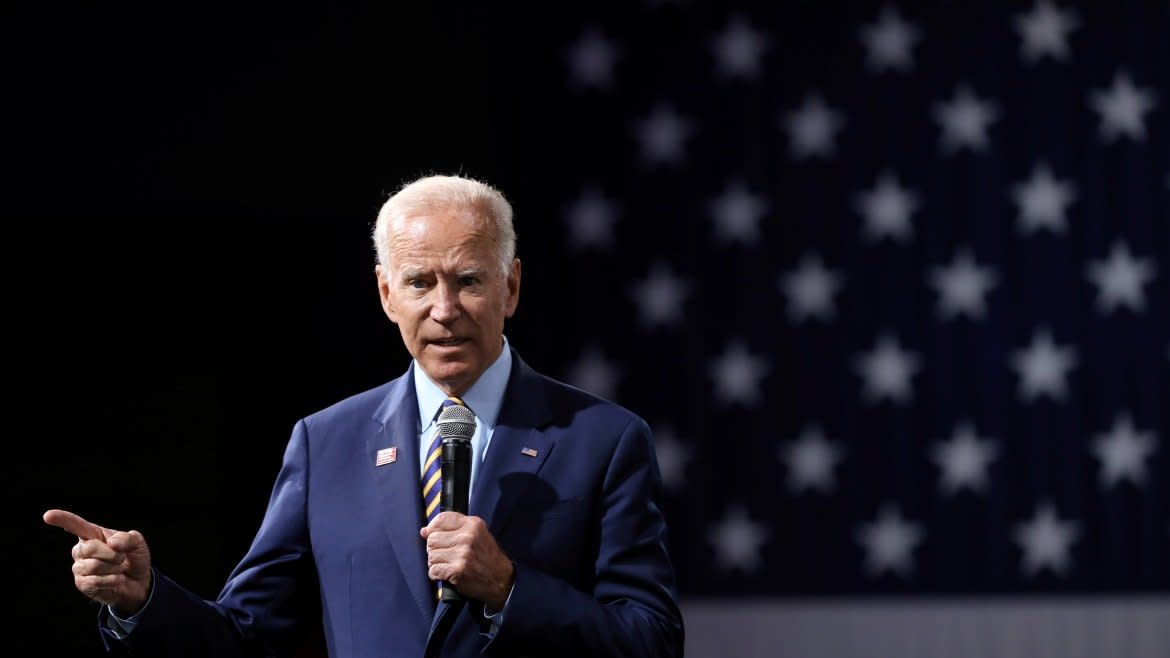Team Biden Says Path to Victory Could Go Through These Red States

In a briefing call with reporters on Friday afternoon, senior Biden campaign officials outlined their internal “clear” path to victory, pointing to key areas they need to protect, win back, and expand in order to win against President Trump in November.
Among the 16 states included in the campaign’s calculus for success with 270 electoral votes, officials cited what they described as three new battlegrounds, Arizona, Georgia, and Texas, as some of the biggest points of possible expansion in 2020.
“I’m bullish about Arizona,” campaign manager Jen O'Malley Dillon said in an hour-long debrief. “Arizona is a battleground state for the first time.”
The strategy for Arizona includes persuading voters who went for Sen. Mitt Romney (R-UT) in 2012 and Hillary Clinton in 2016, as well as those who helped contribute to the “blue wave” Democratic House sweep in 2018. It also relies on increasing turnout among Latino voters and those under 30. Officials’ internal estimates suggest that 15 to 20 percent of total turnout in the state will come from Latino voters, a bloc that Biden won there in the Democratic primary.
Biden Campaign Is Secretly Building a Republican Group
Beyond those three states, the Biden campaign outlined several other areas they deem important to their electoral pathway. Five states—Nevada, Colorado, Minnesota, Virginia, and New Hampshire—are target areas that Democrats won in 2016 and remain critical to the campaign’s coalition in November, senior officials said.
Among those areas that went for former President Barack Obama in 2008 or 2012 but flipped for Trump in 2016, officials see Iowa, Wisconsin, Michigan, Pennsylvania, Florida, North Carolina, and Maine as possible avenues to achieve success.
O’Malley Dillion said the campaign is “pulling ahead” in Florida, Pennsylvania, Michigan, Wisconsin, and Arizona. “If we kept these numbers, and we kept them through November, that would put us at 318 electoral votes,” she said.
“We believe to win we must have a customized approach in each battleground state,” she added. “There is no cookie cutter approach. There is no national election.”
Senior officials also outlined what the so-called “Biden coalition” will look like, drawing from three groups: young, African American, and Latino voters; suburban, college educated voters, and women; and disaffected voters.
“We believe that we do not have to make a choice between one group or another group in terms of how we are going to win this,” O'Malley Dillon said.
The campaign’s internal polling shows a 5 point increase from 2016 with women and a 3 point increase with white college graduates, for example, part of a key constituency that has grown more supportive of Democrats since 2012. In addition, among disaffected voters, which includes non-college educated white voters, blue-collar workers, African American and Latino men, and Obama-Trump voters who have grown less supportive of Democrats since 2016, officials see additional pickup opportunities.
In 2016, 10 percent of Trump voters went for Obama in 2012. In addressing this, officials note that the former vice president saw “significant support” with that group in the primary, including winning working class voters in Michigan by 14 percent.
“These voters can be won by the vice president,” O'Malley Dillon stressed.
On a messaging front, Biden’s top lieutenants plan to build out the strongest possible contrast with Trump with its long standing pitch for unity, a call they believed helped propel the former vice president to victory against over a dozen opponents in the Democratic primary. In particular, officials said they plan to spotlight Trump’s inability to keep the public health and economic impact of the COVID-19 pandemic under control.
“Presidents get measured by how they are seen in a crisis,” Mike Donilon, the campaign’s chief strategist, said. “What the country saw with Donald Trump in this crisis was this: he was unprepared for it when it came. And then when it came, he failed to act. He didn’t act decisively. What he did was, he froze.”
Navigating the virtual campaign season in the thick of coronavirus has been one of the centerpoints of contrast between Trump, who has held regular briefings rife with chaos broadcast on cable news, and Biden, who has largely been confined to a livestream broadcast from his basement.
Officials on Friday saidthe campaign expects to continue to ramp up its digital capacity in the coming days and weeks, including by debuting a new livestream platform over the weekend.
The campaign will have “a number of significant announcements coming over the next 10 days,” O'Malley Dillon said.
Get our top stories in your inbox every day. Sign up now!
Daily Beast Membership: Beast Inside goes deeper on the stories that matter to you. Learn more.

